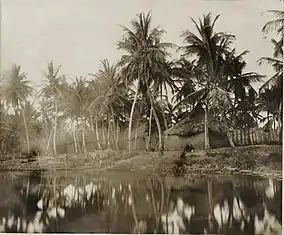Keta
Keta is a town in the Volta Region of Ghana. It is the capital of the Keta Municipal District.[2]
Keta
Ketta, Quittah | |
|---|---|
Town & Municipality Capital | |
 Fort Prinsensten on the beach of Keta in 1985 | |
 Keta Location of Keta in Volta | |
| Coordinates: 5°55′N 0°59′E | |
| Country | |
| Region | |
| District | Keta Municipal District |
| Population (2013) | |
| • Total | 23,207[1] |
| • Density | 1,829/sq mi (706/km2) |
| Ranked 61st in Ghana | |
| Time zone | GMT |
| • Summer (DST) | GMT |
| Area code(s) | +233 (3626) |
Keta is the sixty-first most populous settlement in Ghana in terms of population, with a population of 23,207.[1] Parts of the town were devastated by sea erosion between the 1960s and 1980s. Keta is mentioned in Maya Angelou's All God's Children Need Traveling Shoes.
History

Keta was settled by the Anlo Ewe, a sub-group of the Ewe people who, in the 17th century, migrated to the area from Ketu, in Benin.
Keta was an important trading post between the 14th and the late 20th centuries. The town attracted the interest of the Danish, because they felt they could establish a base here without interference from rival European nations. Their first initiative was to place a factory at Keta to sell alcohol.[4]
In 1792, a war between Anloga and Keta broke out.
Faced with the threat of war between Peki and an alliance of the Ashanti and the Akwamu, the North German Missionary Society (also known as the Bremen Missionaries) moved the focus of their activities from Peki to Keta. Their missionaries, Dauble and Plessing, landed at nearby Dzelukofe on September 2, 1853.[5]
Historically Keta was also known as Quittah and was assigned B27 as a postal mark.[6]
From 1874 Hausa Constabulary were based at Keta, and soon there grew to be a community of Hausa traders in the town.[4]
The author, and then colonial Civil Servant, Dr. R. Austin Freeman served as an medical officer (Assistant Surgeon) here in 1887 during which an epidemic of black water fever killed forty per cent of the European population.[7]
Ecology
In 1784, Fort Prinzenstein, like most slave trade forts, was built by the sea's edge. However the sea had retreated by about 600 ft by 1907. Since then Keta has been subject to sustained erosion. The Bremen Factory and Coconut plantation, which were close to the high water mark in 1907, had been swept away by the sea by 1924. The erosion has now advanced as far as Queen Street and started to wear away the Fort.[4]
Close to Keta is the famous town of Woe, known for the notable lighthouse called Cape St. Paul Lighthouse[8] on the beach that is believed to guide ships away from a mythical massive underwater mountain. This lighthouse is also thought to be the oldest in Ghana.[9]
Keta Lagoon
Keta Lagoon is the largest lagoon in Ghana with a water area of 300 km2. This is located in a larger wetlands protected area of 1200 km2. It is a stopping point for a large number of migratory birds and provides a breeding ground for sea turtles.[10] The Keta Lagoon is known for its immense quantity of salt.[11]
Festival
Keta Sometutuza Festival[12]hogbetsotso za
Oil
Oil has been found at the Keta Basin. However, experts are against the exploitation because it will be on land which lead to the destruction of land and lives, as well as some sources of livelihood.[13]
Education
The city can boast of notably finest schools in the Volta Region.
- Keta Senior High Technical School
- Keta Business College
Attractions
Keta community has a few tourist attractions which one can enjoy whiles in the town.
- Aborigines Beach Resort
- Keta Lagoon Rest Stop
- Keta Lagoon Resort
- Fort Prinzenstein
- Gobah Beach
References
- "World Gazetteer online". World-gazetteer.com. Archived from the original on 2012-01-11.
- Touring Ghana - Volta Region Archived 2012-04-14 at the Wayback Machine. touringghana.com.
- Akyeampong, Emmanuel Kwaku (2001). Between the Sea and the Lagoon. Oxford: James Currey. p. 46. ISBN 0-85255-776-0.
- Agbeti, J Kofi (1986). West African Church History: Christian Missions and Church Foundations 1482-1919. Leiden: Brill Archive.
- "British Commonwealth Postmarks". Philatelic Bibliopole. Retrieved 2 April 2014.
- Freeman, Richard Austin (1898). "XVII A Chapter on Malaria". Travels and Life in Ashanti and Jaman. New York: F. A. Stokes. p. 502. Retrieved 2020-07-05 – via The Hathi Trust (access may be limited outside the United States).
- "about this municipality". ghanadistricts.gov.gh. Retrieved 19 January 2014.
- Briggs, Philip (2010). Ghana. Bradt Travel Guides. p. 234. ISBN 9781841623252.
woe keta.
- "Keta Lagoon Complex Ramsar Site". Retrieved 5 April 2014.
- Webby. "Keta Lagoon". Ghana Nation. Ghana Nation. Retrieved 19 April 2018.
- "Archived copy". Ghana Expeditions. Archived from the original on 20 April 2018. Retrieved 19 April 2018.CS1 maint: archived copy as title (link)
- "Oil & Gas Expert Warns Against Exploration in Keta Basin". Retrieved 19 April 2018.

